The Hanging Church: A Fascinating Blend of Christian and Islamic Architecture
The Hanging Church, also known as the Church of the Virgin Mary, is a fascinating architectural wonder that blends Christian and Islamic design elements. Constructed in the 7th century AD, this ancient church showcases a fusion of Roman-Byzantine and early Islamic architectural styles. Its unique location on top of the walls of the Roman fortress of Babylon in Cairo, Egypt, gives it the nickname "Hanging Church."
With its ornate interior adorned with bone and ivory inlaid designs, the Hanging Church stands as a testament to Egypt's rich history and cultural diversity. Join us as we explore this remarkable religious site's mesmerizing beauty and historical significance.

The History and Significance of The Hanging Church
The Hanging Church, also known as the Saint Virgin Mary's Coptic Orthodox Church, holds a significant place in the history and culture of Egypt. This ancient church is believed to have been built on the site where the Holy Family took shelter during their flight to Egypt. The church's name, "The Hanging Church," refers to its suspended position above a Roman fortress gatehouse. This unique architectural feature was built to protect the structure from rising Nile waters.
The Hanging Church is not only significant for its historical and religious importance but also for its architectural blend. The church showcases a remarkable fusion of Christian and Islamic architectural elements. Its design incorporates Roman, Byzantine, and early Islamic styles, resulting in a distinctive aesthetic that reflects Egypt's diverse cultural influences throughout history.
The church's construction process is fascinating, with layers of different architectural styles added over the centuries. The original structure is believed to date back to the 4th century, with subsequent modifications and additions made during the 7th and 8th centuries.
The church's main entrance, iron gates, and bell towers are striking features that exemplify the blend of Christian and Islamic influences. The intricately carved wooden screen inside the church is another noteworthy element, adorned with delicate designs and patterns.
Today, the Hanging Church serves as the seat of the Coptic Orthodox Pope and holds great significance for the Coptic Christian community in Egypt. It has witnessed historically crucial events and is a venue for religious ceremonies and celebrations.
Located in Old Cairo, the Hanging Church is easily accessible for visitors wanting to witness this architectural marvel and appreciate its unique blend of Christian and Islamic architecture.

Overview of its unique architectural blend
The Hanging Church, also known as the Saint Virgin Mary's Coptic Orthodox Church, is a fascinating architectural marvel that blends Christian and Islamic influences. Its unique architectural blend reflects Egypt's historical and cultural fusion throughout the centuries.
The church's architecture combines elements of Roman, Byzantine, and early Islamic styles. It features a basilica plan with three main aisles separated by columns reminiscent of early Christian churches. The walls are constructed using mud brick, a common building material during the early Islamic period.
One of the striking features of the Hanging Church is its intricately designed wooden screen, known as the iconostasis. This screen divides the nave from the sanctuary and is adorned with exquisite carvings and paintings of biblical scenes and saints. The detailed decorations on the screen showcase the influence of Coptic art, which has its roots in ancient Egyptian artistic traditions.
The church's bell towers and iron gates add to its unique architectural character. The bell towers, built in the Islamic style, feature pointed arches and delicate geometric patterns. The iron gates, adorned with crosses and Islamic crescents, symbolize the coexistence of Christianity and Islam in Egypt.
Overall, the Hanging Church stands as a testament to Egypt's rich cultural heritage and architectural diversity. It is a must-visit destination for anyone interested in exploring the country's crossroads of Christianity and Islam.
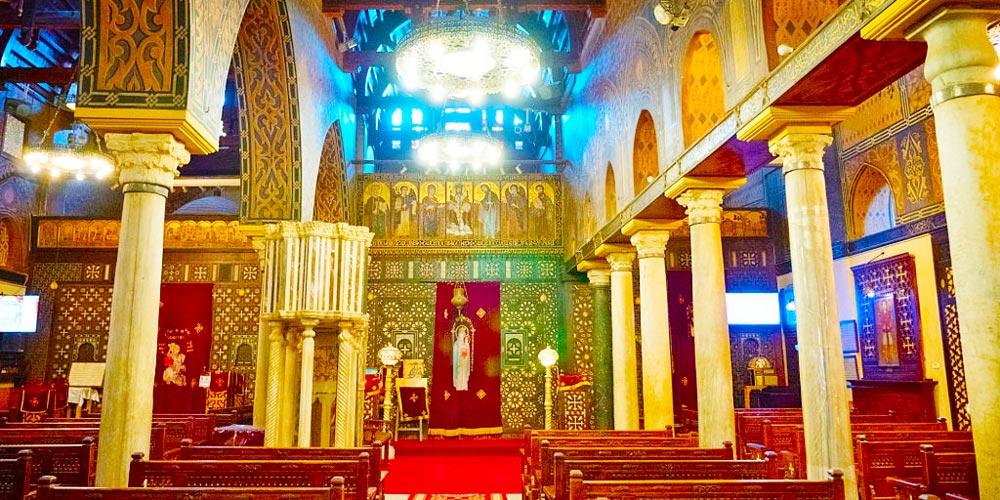
The construction process of The Hanging Church
The construction process of The Hanging Church, also known as St. Virgin Mary's Coptic Orthodox Church, was a remarkable feat of engineering and craftsmanship. Built around the 7th century AD, the church is suspended over the southern gate of the Babylon Fortress, giving it its unique name.
Here are some key aspects of the construction process:
-
Foundation: The Hanging Church was constructed on the remnants of a Roman tower. Its foundations were reinforced with arches to distribute the structure's weight.
-
Materials: The church was primarily built using stone and brick, readily available in the area. These materials were meticulously shaped and arranged to create the church's distinctive architectural features.
-
Architectural Blend: The church's construction incorporated elements from various architectural styles, including Roman, Byzantine, and early Islamic influences. This amalgamation of styles resulted in a harmonious fusion of Christian and Islamic features.
-
Roof Structure: The church features a wooden roof supported by wooden beams and columns. This intricate roof structure adds to the overall beauty and elegance of the church's architecture.
-
Decorative Details: The construction process involved the meticulous carving of decorative motifs, intricate religious icons, and geometric patterns, highlighting the attention to detail and craftsmanship of the builders.
The construction of The Hanging Church is a testament to the architectural ingenuity of the time and continues to captivate visitors with its unique blend of Christian and Islamic aesthetics.

Influence of Roman, Byzantine, and early Islamic Architecture
The Hanging Church, the St. Virgin Mary's Coptic Orthodox Church, showcases a fascinating blend of architectural styles from different eras. Its unique design reflects the influence of Roman, Byzantine, and early Islamic architecture.
During the church's construction, which dates back to the 4th century, the architects combined elements from these diverse architectural styles. The Roman influence can be seen using vaulted ceilings and arches, while Byzantine architectural characteristics, such as mosaics and domes, can also be observed. Additionally, incorporating early Islamic architectural elements, including pointed arches and geometric patterns, adds another layer of intrigue to the design.
This captivating blend of architectural styles highlights the historical significance of the church and showcases the cultural and religious exchange that took place in the region over the centuries. The unique combination of these architectural elements creates a visually stunning and historically significant structure that attracts visitors worldwide.
Here are some key features of The Hanging Church influenced by Roman, Byzantine, and early Islamic architecture:
- The use of vaulted ceilings and arches is reminiscent of Roman architecture.
- Byzantine mosaics adorn the interior, showcasing intricate designs and religious iconography.
- Domed roofs add a sense of grandeur and echo the Byzantine architectural style.
- Pointed arches and geometric patterns influenced by Islamic architecture.
- Incorporating decorative elements such as marble columns and wooden screens showcases craftsmanship from various architectural traditions.
Overall, the influence of Roman, Byzantine, and early Islamic architecture on The Hanging Church creates a captivating and harmonious blend of styles that adds to its allure and historical significance.
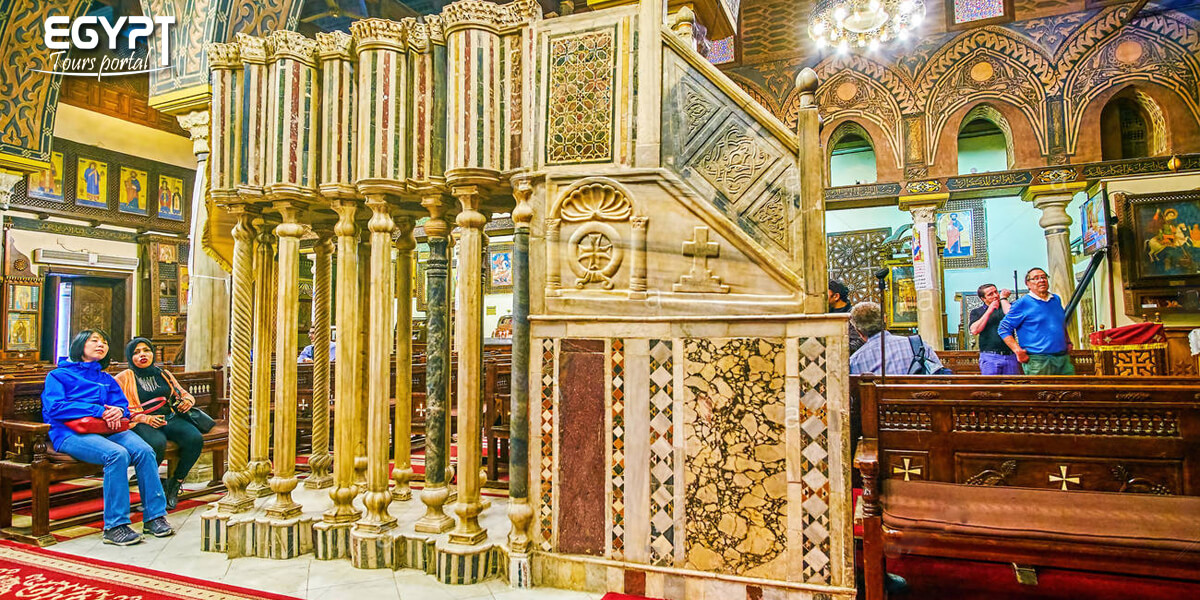
Features and Decorations
Exploring the main entrance, iron gates, and bell towers
One of the remarkable features of The Hanging Church is its main entrance, which showcases intricate craftsmanship and architectural details. The entrance is adorned with beautifully designed iron gates carved with delicate patterns and motifs. These gates not only provide security but also add to the aesthetic appeal of the church.
As you enter through the gates, you are greeted by the grandeur of the bell towers. The bell towers of The Hanging Church are an integral part of its architectural design and are notable for their unique blend of Christian and Islamic influences.
The bell towers, constructed in a style reminiscent of Islamic minarets, feature architectural elements such as pointed arches and decorative motifs that reflect the influence of both Roman and Islamic architecture. They serve as a visual representation of the cultural and religious fusion characteristic of The Hanging Church. The towers also house the church bells, traditionally used to announce religious services and mark important occasions in the Coptic Christian calendar.
Visitors to The Hanging Church can marvel at the exquisite craftsmanship and historical significance of the main entrance, iron gates, and bell towers. These architectural elements serve practical purposes and symbolise the church's rich heritage and the cultural diversity of Coptic Cairo.
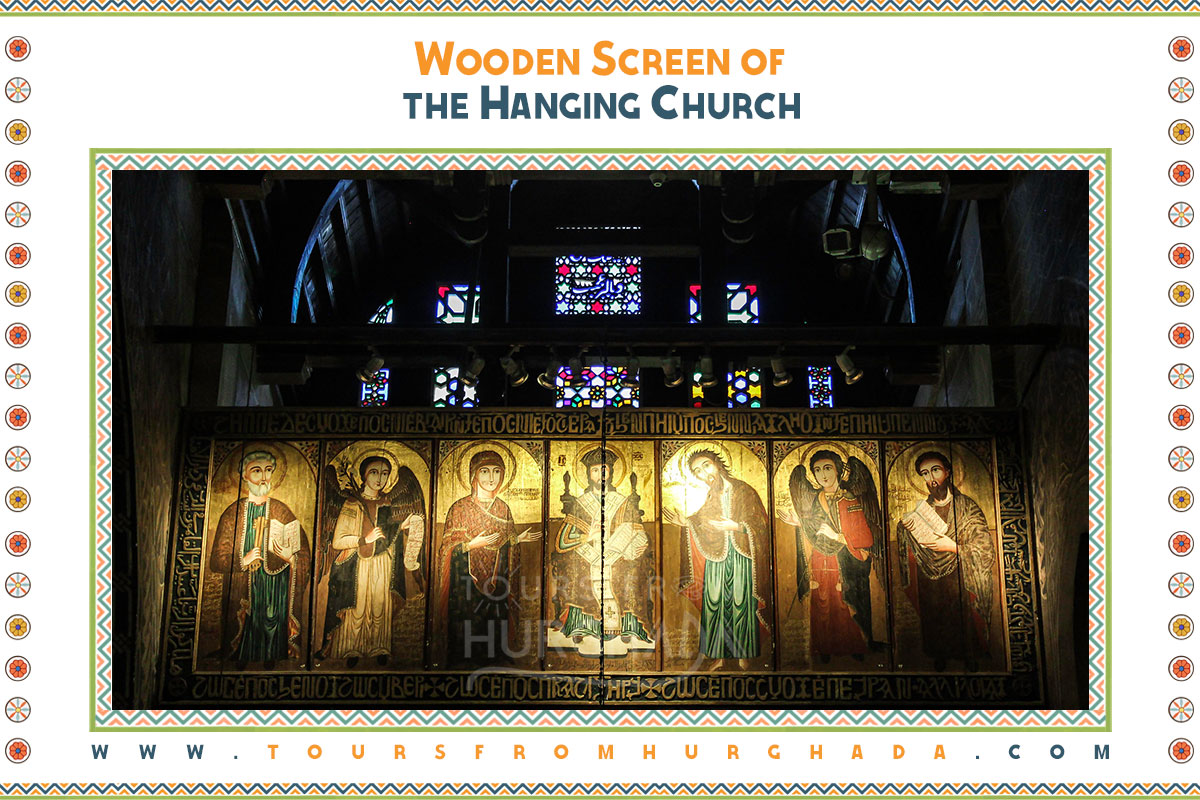
The collection of enchanting icons inside the church
The collection of enchanting icons inside The Hanging Church
Inside The Hanging Church, visitors are treated to a stunning collection of icons that showcase the rich history and artistic traditions of the Coptic Church. These icons, mostly painted on wood panels, depict various biblical scenes and religious figures, visually representing the Coptic Christian faith.
The icons in The Hanging Church are known for their vibrant colours, intricate details, and delicate brushwork. They offer a glimpse into the spiritual world of the Coptic Church and provide a deeper understanding of its beliefs and traditions. Each icon tells a story and invites contemplation and reflection.
Some notable icons in The Hanging Church include depictions of Mary and Jesus, the Last Supper, the Crucifixion, and various saints and martyrs. Each icon is unique and exudes a sense of sacredness and devotion.
Visitors to The Hanging Church can spend hours exploring the collection, marvelling at the artists' skills and immersing themselves in the spirituality of the Coptic tradition. The icons serve as visual prayers, inviting visitors to connect with their faith on a deeper level.
Overall, the enchanting icons inside The Hanging Church add to its allure and make it a must-visit destination for art enthusiasts and those interested in religious history.
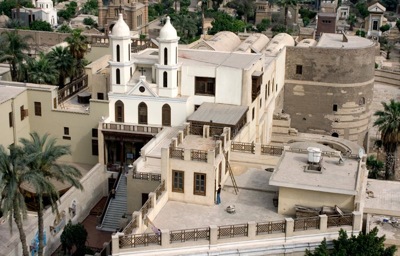
The wooden screen and its intricate decorations
The wooden screen in The Hanging Church is a remarkable piece of art that showcases intricate craftsmanship and decorative elements. Located near the entrance of the church, the wooden screen acts as a barrier between the nave and the sanctuary. It is a visual focal point that captures visitors' attention with its stunning details and design.
The screen is adorned with geometric patterns, intricate carvings, and decorative motifs reflecting Christian and Islamic influences. The blend of these two architectural styles highlights the rich cultural history of Egypt, where different religions and traditions have coexisted for centuries.
The intricate decorations on the wooden screen include floral patterns, calligraphy, and depictions of biblical scenes. These carvings and designs are meticulously crafted, showcasing the skill and talent of the artists who worked on them.
The screen serves as a decorative element and has a functional purpose. It separates the nave, where the congregation gathers, from the sanctuary, where the altar is located. The screen creates a sense of reverence and separation between these two spaces, enhancing the spiritual atmosphere of the church.
Visitors to The Hanging Church can marvel at the exquisite beauty of the wooden screen and appreciate the harmonious blend of Christian and Islamic architectural styles. It is a testament to Egypt's rich history and cultural diversity, making The Hanging Church a truly unique architectural marvel.
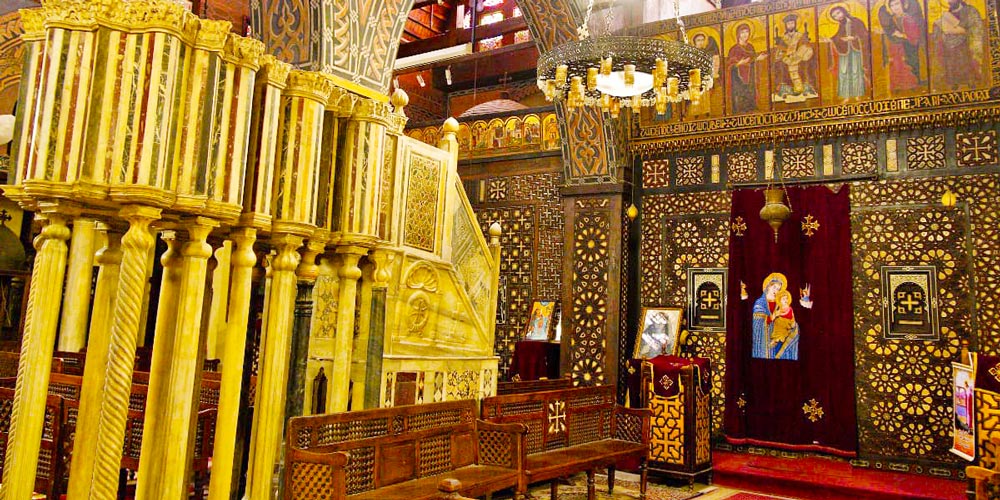
Importance in Coptic Christianity
The Role of The Hanging Church in Coptic Cairo
The Hanging Church, or Saint Virgin Mary's Coptic Orthodox Church, is significant in Coptic Cairo. It is the oldest church in the area and has played a vital role in the spiritual and cultural life of the Coptic community.
As the residence of the Coptic patriarch, the Hanging Church is not only a place of worship but also a centre for the administration of the Coptic Orthodox Church. The patriarch considered the Coptic Christians' spiritual leader, resides in a section of the church complex. This adds to the church's importance and makes it a destination for Coptic Christians worldwide.
Over the centuries, the Hanging Church has witnessed historically crucial events and hosted various religious ceremonies. It has been a venue for the consecrations of new bishops, ordinations, and even the annual celebrations of the Coptic Christmas and Easter. The church's immense historical and religious significance attracts pilgrims and tourists alike, who visit to experience the unique spiritual atmosphere and connect with the rich history of the Coptic community.
Located in Old Cairo, the Hanging Church is easily accessible to visitors. Its proximity to other Coptic sites, such as the Coptic Museum and the Babylon Fortress, makes it a must-visit destination for those interested in exploring the cultural and religious heritage of Coptic Cairo.
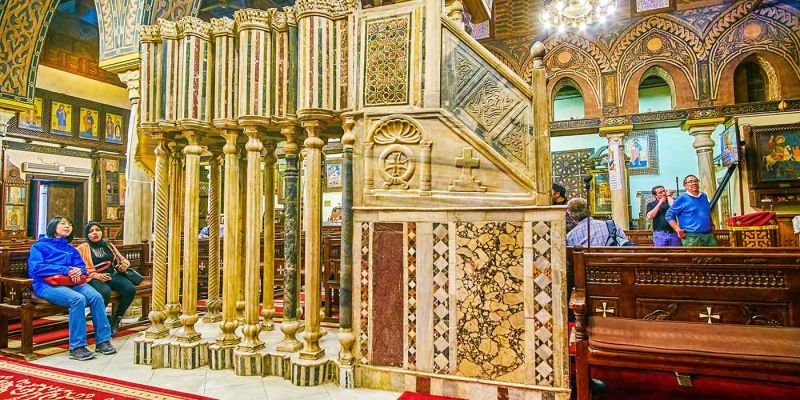
Its significance as the residence of the Coptic patriarch
One of the significant aspects of The Hanging Church is its historical significance as the residence of the Coptic patriarch.
The Coptic Orthodox Church is the largest Christian denomination in Egypt, and the patriarch is the church's leader. The patriarch is responsible for overseeing the spiritual guidance and administration of the Coptic Orthodox community.
The Hanging Church, also known as Saint Virgin Mary's Coptic Orthodox Church, has been the residence of the Coptic patriarch in the past. This adds to its importance and makes it a significant religious site for Coptic Christians.
As the residence of the Coptic patriarch, the church has witnessed historically crucial events and religious ceremonies. It has been a centre of religious authority and where important decisions and spiritual guidance have been provided to the Coptic Orthodox community.
Today, while the residence of the Coptic patriarch has been moved to another location, The Hanging Church still holds a special place in the hearts of Coptic Christians. It continues to be a symbol of their faith and a site of pilgrimage and worship. Visitors can experience the rich history and spirituality of the Coptic tradition by visiting this architectural marvel in Old Cairo.
The significance of The Hanging Church as the former residence of the Coptic patriarch adds to its allure. It makes it a must-visit destination for those interested in exploring the religious and architectural heritage of Egypt.

Witnessing historically crucial events and religious ceremonies
Witnessing historically crucial events and religious ceremonies at The Hanging Church is a remarkable experience that offers a deep connection to Egypt's rich cultural and religious heritage. Throughout its history, this iconic church has witnessed numerous significant events and played a vital role in religious ceremonies.
One such event was the coronation of several Coptic patriarchs, making it an important venue for passing spiritual leadership. The Hanging Church has also been where important religious ceremonies, such as Christmas and Easter, are celebrated with great splendour and reverence. These ceremonies attract many visitors and devotees who witness and participate in the religious rituals.
Moreover, The Hanging Church has been at the heart of Egypt's historical milestones. It has witnessed the rise and fall of empires, including the Roman, Byzantine, and Islamic periods. It has survived wars, invasions, and the test of time, symbolising resilience and religious continuity. Its historical significance makes visiting the church an opportunity to connect with the past and appreciate the layers of history that have shaped Egypt's diverse cultural landscape.
Overall, The Hanging Church's role as a witness to historically crucial events and a venue for religious ceremonies makes it a captivating destination for those seeking to delve into Egypt's rich history and experience the spiritual heritage of the Coptic community.

The Hanging Church Today
Its current location and accessibility in Old Cairo
The Hanging Church, St. Virgin Mary's Coptic Orthodox Church, is in Old Cairo, Egypt. It is on top of the southern gate of the Roman fortress of Babylon, built in the 3rd century AD. This strategic location places the church close to several other historical landmarks, such as the Coptic Museum and the Ben Ezra Synagogue.
Access to the Hanging Church is relatively easy, as it is located in the heart of Old Cairo and is well-connected by public transportation. Visitors can take a taxi or use the Cairo Metro to reach the area. Once at the church, tourists can enter through the main entrance, accessed by ascending a flight of stairs. The church is open to the public for visits and worship, and guided tours are available to provide visitors with insights into the history and significance of the site.
Visiting the Hanging Church during weekdays is recommended, as it tends to be less crowded than at weekends. Photography is allowed inside the church, allowing visitors to capture this unique religious site's beauty and architectural marvels. As the church is an active place of worship, it is important to dress modestly and respectfully while visiting, with women and men covering their shoulders and knees.
The Hanging Church combines elements of Christian and Islamic architectural styles, making it a truly unique and fascinating site to explore. Its current location in Old Cairo makes it an accessible and must-visit destination for those interested in Egypt's history, art, and religious significance.
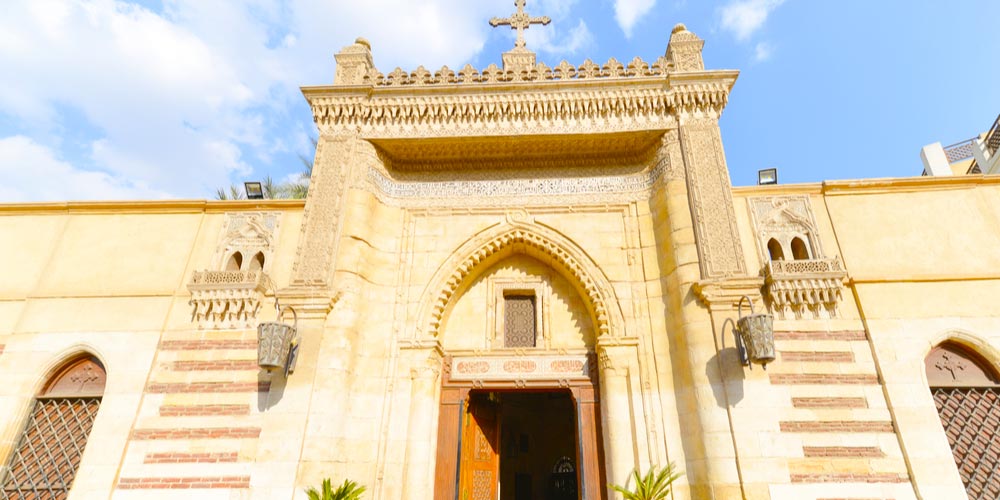
Visiting and experiencing the architectural marvel
Visiting and experiencing The Hanging Church is a unique opportunity to witness an architectural masterpiece that seamlessly blends elements of Christian and Islamic design:
-
Location and Accessibility: The Hanging Church, also known as St. Virgin Mary's Coptic Orthodox Church, is located in the heart of Old Cairo, making it easily accessible to locals and tourists. Its close proximity to other historical sites, such as the Babylon Fortress and the Ben Ezra Synagogue, makes it a must-visit destination for those interested in exploring the area's rich history.
-
Architectural Marvel: Upon entering the church, visitors are greeted by a stunning display of architectural brilliance. The interior combines Roman, Byzantine, and early Islamic architectural styles, creating a captivating fusion of traditions. The ornate wooden screens, intricately designed icons, and beautifully crafted decorations add to the overall grandeur of the church.
-
Religious Significance: The Hanging Church holds immense importance for the Coptic Orthodox community. Not only is it the residence of the Coptic patriarch, but it has also witnessed historically crucial events and religious ceremonies throughout the centuries. Visitors have the opportunity to immerse themselves in the rich religious and cultural heritage of the church.
-
Cultural Experience: Visiting The Hanging Church offers a unique cultural experience that allows visitors to learn about the fascinating blend of Christian and Islamic influences in Egypt's history. Exploring the church's architectural details and understanding its historical significance provides insight into the country's diverse and inclusive heritage.
Whether you're an architecture enthusiast, a history buff, or simply seeking a captivating cultural experience, visiting The Hanging Church promises to be a memorable and enlightening journey into the past.

Appreciating its unique blend of Christian and Islamic architecture
When visiting The Hanging Church, one cannot help but be in awe of its unique Christian and Islamic architecture blend. This architectural marvel showcases the rich history and cultural exchange that Egypt has experienced over the centuries.
The church's exterior features elements of both Christian and Islamic design. The building incorporates elements such as pointed arches, characteristic of Islamic architecture, and traditional Christian symbols such as crosses and religious inscriptions. The blending of these architectural styles creates a visually stunning and harmonious structure.
Inside the church, visitors can admire the enchanting icons and ornate decorations that adorn its walls. The icons depict scenes from the life of Jesus, the Virgin Mary, and various saints, showcasing the Coptic Christian tradition. These artworks are beautifully crafted and serve as a testament to the region's rich artistic heritage.
The wooden screen, known as the iconostasis, is another highlight of the church. It features intricate carvings and a barrier between the sanctuary and the nave. The screen is adorned with religious motifs and acts as a visual representation of the connection between the earthly and spiritual realms.
Visiting The Hanging Church provides a unique opportunity to appreciate the cultural fusion that has shaped Egypt's architectural landscape. Whether marvelling at the exterior, exploring the interior, or reflecting on its historical significance, this remarkable structure stands as a testament to the artistic brilliance and religious tolerance that has characterized Egypt throughout its history.
